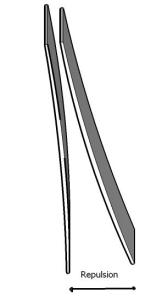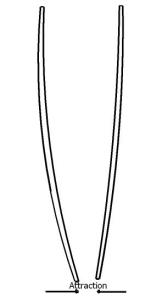Today’s post continues on the experimental electrostatics theme from the previous post. We notice charge induction by polarisation and a neat way to distinguish between conductors and insulators through a definite observation that doesn’t rely on measurements or intricate apparatus.

Fig: 1 Rod, conductor and foil bit
In Fig: 1 above, there is a charged rod, a brass sphere mounted on top of an insulating stand and a conducting foil bit suspended by an insulating string. The rod is charged by rubbing with fake fur, where the abrasion causes exchange of charges. The brass sphere and foil bit are both momentarily grounded by touching with fingers. When the rod is brought close to the sphere as shown, it is observed that the foil bit is attracted to the sphere, and after making contact, repelled strongly. The string attached to the foil bit now makes a noticeable angle with the vertical, signifying the strength of repulsion.
To explain this, let us assume that the charged plastic rod carries a negative charge. As this approaches the neutral brass sphere, it polarises the charges in the sphere. Since brass is a metallic alloy, we can assume the electrons to be free to move around in a lattice of positively charged ions. In this case, the electrons feel a force or repulsion from the net. negative charge of the plastic rod and they are redistributed on the surface of the sphere in a manner that balances the repulsion between the concentrated electrons on the right side and the repulsion from the rod on the left. In a very short time (nearly instantaneous to our observation) the centre of charge of the electrons shifts to the right of the sphere. The right side of the sphere now carries a net negative charge whereas the left side carries a net. positive charge, making it an effective dipole. Since the brass mass rests on an insulating stand, any local excess of charge on it is not grounded. The same applies to the aluminium foil bit which hangs on an insulating string.
The brass sphere dipole polarises the charged bit by repelling the electrons in the aluminium foil to the far side and making the latter an effective dipole too. Although the former polarisation was from an object with an excess charge, and the latter from an object which is a neutral dipole, the effect is similar. This accentuates the point that electrostatic force, which seeming to act at a distance, is only a consequence of local effects that build up. In both cases in this experiment, there is a difference in the kind of charges perceived, which can also be thought of as the net. electric field. The polarised aluminium foil is attracted to the brass sphere because after polarisation, the unlike charges are closer and hence the force between them stronger than the like charges. There was also a force between the sphere and the charged rod, but not enough to overcome the restraints on them. The foil bit, on the other hand, moves to touch the right side of the sphere. Since they are both conductors, there is a redistribution of charge between the negatively charged right side of the sphere and positively charged left side of the foil bit. This reduces the negative charge on the right side of the sphere a little, but the foil bit still sees it as a negative charge. But, the charge on the foil bit was not as high to start with and the redistribution left it with so much net negative charge that the brass sphere now sees it as a negative charge. Hence, they repel.
From our explanation, we can see that for the latter repulsion to occur, the charge content on the foil bit should be much less than the brass sphere. This is ensured by their sizes and the weakening of charge induction as we move down the chain. Finally, if we are to touch the negatively charged foil bit with a finger, its excess charge will instantly be grounded and it will be polarised by and attracted to the brass sphere again. The attraction to and repulsion from the sphere will produce an oscillation of the foil bit between the sphere and the finger, as charge moves from the sphere through the bit and the finger to ground. This loss of negative charge makes the sphere progressively more positively charged. If the charged rod were pulled away from the brass sphere, the polarisation on the sphere will be lost and the oscillation will eventually die down when the charge on the sphere is lost.
The above explanation would work just as well if we had called the charge on the rod positive. While the charges on the rest of the objects will change too, the motions and other observables will be unchanged. We also need to remember that the definitions of conductor and insulator are subjective to the application. There is no strict demarcation between them, at least not one that is accepted in every case. Finally, I stress that our explanation above is by no means complete. It is just something that is not falsified by experiment, seems to fit the facts and our knowledge of electrostatics and is not too hard for me to understand. The acceptance that there is a deeper understanding that currently eludes us is not necessarily discouraging. There is still beauty in the patterns that we do discern in nature and still intrigue in searching for more beautiful ones further.



Recent Comments